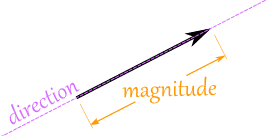The altitude, equal sides, and nonequal sides of an isosceles triangle have lengths that are, in the order listed, consecutive even numbers of centimeters.
What is the area of the triangle?
The (even) altitude = 2k for some integer k.
The slanted side = 2k + 2
The base is 2k + 4, so half of it is k + 2.
The altitude of an isosceles triangle splits it into two right triangles,
so from the Pythagorean Theorem we have:
(k + 2)^2 + (2k)^2 = (2k + 2)^2
k^2 + 4k + 4 + 4k^2 = 4k^2 + 8k + 4
k^2 = 4k
k = 0 or 4
0 would not be a "triangle", but if you allow for
the degenerate case of 0 altitude, 2 on the sides and 4 on the base, the numbers work,
and the area is 0.
For k = 4, we have:
altitude 8, sides 10, base 12 (two 6-8-10 right triangles, which also have consecutive even sides)
and the area is 8 * 12/2 = 48
Thursday, April 10, 2014
No.38
Adding Vectors
And here is how to add two vectors after breaking them into x and y parts:

The vector (8,13) and the vector (26,7) add up to the vector (34,20)
Example: add the vectors a = (8,13) and b = (26,7)
c = a + b
c = (8,13) + (26,7) = (8+26,13+7) = (34,20)
Subtracting Vectors
Remember: to subtract, first reverse the vector you want to subtract, then add.
Example: subtract k = (4,5) from v = (12,2)
a = v + -k
a = (12,2) + -(4,5) = (12,2) + (-4,-5) = (12-4,2-5) = (8,-3)
Magnitude of a Vector
The magnitude of a vector is shown by two vertical bars on either side of the vector:
|a|
OR it can be written with double vertical bars (so as not to confuse it with absolute value):
||a||
You can use Pythagoras' theorem to calculate it:
|a| = √( x2 + y2 )
A vector with magnitude 1 is called a Unit Vector.
Vector vs Scalar
When using vectors we call an ordinary number a "scalar".
Scalar: just a number (like 7 or -0.32) ... definitely not a vector.
A vector is often written in bold,
so c is a vector, and it has magnitude and direction
but c is just a value, like 3 or 12.4
Example: kb is actually the scalar k times the vector b.
No.37
Vectors
This is a vector:

A vector has magnitude (how long it is) and direction:

The length of the line shows its magnitude and the arrowhead points in the direction.
You can add two vectors by simply joining them head-to-tail:

And it doesn't matter which order you add them, you get the same result:

Subscribe to:
Comments (Atom)
